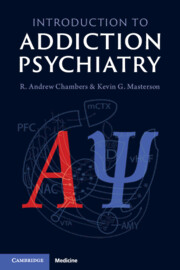Book contents
- Introduction to Addiction Psychiatry
- Introduction to Addiction Psychiatry
- Copyright page
- Contents
- Preface
- 1 Population Impact: Epidemiology
- 2 Specific Symptom Sets: Clinical Phenomenology
- 3 A Disorder of Anatomical Structure and Function: Neurobiology
- 4 Biological Risk Amplification: Disease Vulnerability
- 5 Diagnosis and Treatment: Disease Tracking, Reduction, and Remission
- Index
- References
4 - Biological Risk Amplification: Disease Vulnerability
Published online by Cambridge University Press: 03 April 2025
- Introduction to Addiction Psychiatry
- Introduction to Addiction Psychiatry
- Copyright page
- Contents
- Preface
- 1 Population Impact: Epidemiology
- 2 Specific Symptom Sets: Clinical Phenomenology
- 3 A Disorder of Anatomical Structure and Function: Neurobiology
- 4 Biological Risk Amplification: Disease Vulnerability
- 5 Diagnosis and Treatment: Disease Tracking, Reduction, and Remission
- Index
- References
Summary
As with other diseases, vulnerability to addiction is not evenly distributed in the population. It is concentrated in people that bear higher concentrations of biologically active risk factors. Addiction vulnerability is associated with earlier age of substance use, multiple concurrent addictions, and mental illness. It is determined by complex interactions between many hundreds of genes, and a wide range of environmental–developmental experiences – all of which are biologically active in shaping motivational-behavioral repertoires and cortical–striatal–limbic networks anchored on the NAC. Understanding the developmental neurocircuitry of addiction and its linkage with mental illness informs our understanding of this disease vulnerability. All major forms of mental illness, spanning schizophrenia, bipolar disorder, depression, trauma-spectrum disorders, personality disorders, impulse controls disorders, etc., involve anatomical–functional abnormalities that overlap and interlink with primary motivational circuits involved in addiction. The neurocircuitry of mental illness, involving disrupted inputs from PFC, AMY, HCF, into the NAC, involuntarily alters NAC network responsivity to addictive drugs, allowing their pathological neuroplastic effects to produce more robust and accelerated sensitization of drug-motivated behavior. Similarly, adolescent neurodevelopment is a biological context marked by profound change of motivational-behavioral repertoires – and neural network revision within cortical–striatal–limbic circuits – that increases brain susceptibility to addiction.
Keywords
- Type
- Chapter
- Information
- Introduction to Addiction Psychiatry , pp. 117 - 169Publisher: Cambridge University PressPrint publication year: 2025

